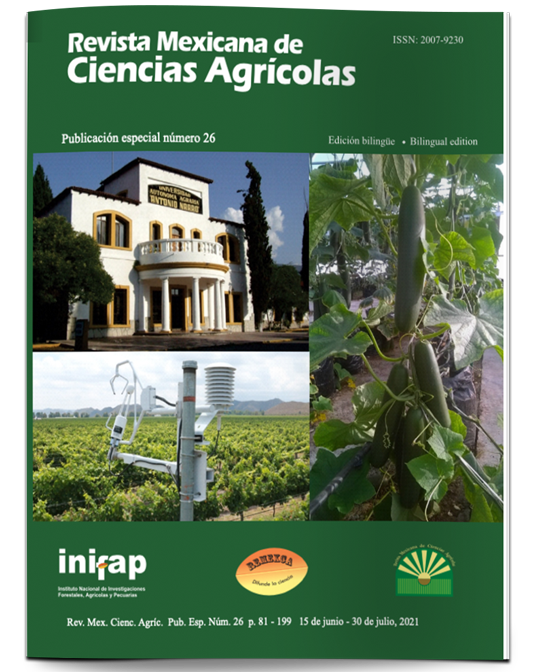Cabbage residues for biocontrol of Fusarium spp. in tomato cultivation
DOI:
https://doi.org/10.29312/remexca.v0i26.2940Keywords:
biofumigation, fusariosis, incidenceAbstract
One of the main phytosanitary problems in the production of tomato (tomate or jitomate in spanish) (Solanum lycopersicon Mill.), where soil is used as a growing medium, is Fusarium spp., chemical control is the method frequently used for its management; with important economic and environmental impacts. The objectives of this study were: to evaluate cabbage as a rotation crop and the incorporation of residues into the soil in the incidence of permanent wilting on tomato plants and the incidence of Fusarium spp., in the soil and evaluate the suppression of Fusarium spp., by applying by-products of cabbage leaves and stems. The study was carried out in two stages: in the first the evolution of Fusarium spp., was documented in a commercial tomato cultivation, established under anti-aphid mesh conditions and cabbage as a rotation crop, during the period 2012 to 2019. In the second stage, an aqueous extract and a dehydrated powder, obtained from residual cabbage leaves and stems, were evaluated. The results show that cabbage used as a rotation crop and the incorporation into the soil of residual leaves and stems reduced the incidence of permanent wilting on tomato cultivation and effectively suppressed Fusarium spp. As well, the dehydrated powder obtained from these residues showed a similar effect on the control of Fusarium spp., to that obtained in treatments with sodium methyldithiocarbamate.
Downloads
Downloads
Published
How to Cite
Issue
Section
License
Copyright (c) 2021 Revista Mexicana de Ciencias Agrícolas

This work is licensed under a Creative Commons Attribution-NonCommercial 4.0 International License.
The authors who publish in Revista Mexicana de Ciencias Agrícolas accept the following conditions:
In accordance with copyright laws, Revista Mexicana de Ciencias Agrícolas recognizes and respects the authors’ moral right and ownership of property rights which will be transferred to the journal for dissemination in open access. Invariably, all the authors have to sign a letter of transfer of property rights and of originality of the article to Instituto Nacional de Investigaciones Forestales, Agrícolas y Pecuarias (INIFAP) [National Institute of Forestry, Agricultural and Livestock Research]. The author(s) must pay a fee for the reception of articles before proceeding to editorial review.
All the texts published by Revista Mexicana de Ciencias Agrícolas —with no exception— are distributed under a Creative Commons License Attribution-NonCommercial 4.0 International (CC BY-NC 4.0), which allows third parties to use the publication as long as the work’s authorship and its first publication in this journal are mentioned.
The author(s) can enter into independent and additional contractual agreements for the nonexclusive distribution of the version of the article published in Revista Mexicana de Ciencias Agrícolas (for example include it into an institutional repository or publish it in a book) as long as it is clearly and explicitly indicated that the work was published for the first time in Revista Mexicana de Ciencias Agrícolas.
For all the above, the authors shall send the Letter-transfer of Property Rights for the first publication duly filled in and signed by the author(s). This form must be sent as a PDF file to: revista_atm@yahoo.com.mx; cienciasagricola@inifap.gob.mx; remexca2017@gmail.
This work is licensed under a Creative Commons Attribution-Noncommercial 4.0 International license.



